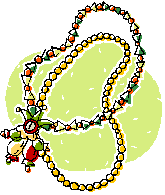



|
Beading Thread - Choosing The Right One By Felicity Walker Walk into any beading store, and once you can tear your gaze away from the amazing variety of beads, you might manage to find the thread section. This is a great opportunity to get completely bamboozled. There are many different types of threads used in beading, so how do you work out which one you need for your project? Let's take a look at what's available. Tiger Tail and Beading Wire There are many variations, but beading wire and tiger tail are basically multiple strands of steel wire covered in plastic or nylon. They are easy to use, come in a variety of gauges, and are particularly good for making jewelry. They're also quite durable, but may be a little difficult to use if you're using knots between beads. Tiger tail is cheaper and can be used for most things, but can sometimes kink when being used. It's easiest to finish pieces made with tiger tail or beading wire using crimps, rather than knots. Synthetic Beading Threads Nymo is one of the most popular synthetic threads, and as it's very fine, is often used for more delicate beadwork. Polyester thread is another option. Generally these threads are used for beadwork that requires needles. Make sure you allow plenty of extra thread if you're going to be weaving or knotting synthetic threads. Natural Threads Silk, linen, cotton and leather are all natural materials that can be used when making beaded jewelry. They're available in a multitude of colors and thicknesses, although some of the very fine silk and linen threads can be easy to break and must be handled carefully. You can also use hemp for beading, but it's generally reserved for chunkier designs, and can be knotted or braided for a great effect. Elastic Thread Again, this can be found in a variety of thicknesses. This type of thread is great for kids to work with, because they can simply tie the ends together when they've finished beading and it stretches when you want to put the jewelry on or take it off. Memory Wire Memory wire is strong, precoiled wire, and is used extensively for making chokers, rings and bracelets. You need heavy-duty tools for cutting memory wire. Although it's a type of wire, it can't be used for wirework, and beads are threaded onto it in a similar fashion to the threads listed above. Metal Wire Metal wires come in copper, silver, gold and brass, as well as silver or gold-plated. These are mostly used for wirework methods of beading, because they can be bent and manipulated into any shape you want. Some of the finer gauge wires are only suitable for decoration purposes, but heavier gauge wires can be used for any type of wire wrapping. It's important to take care when working with metal wires, and in particular, protect your eyes when cutting them. Now when you visit your beading store, you'll at least know what some of the threads you can see are used for. Think about your beading project, including the weight of the beads and the size of their holes, when deciding which thread or wire will be most suitable. Always try to choose the strongest thread possible, so that your piece will be durable, but remember that you still want it to be flexible and have some movement.
About the Author:
|
|
|---|
Search the Web: 
Custom Search
|
Contact Us |
|---|